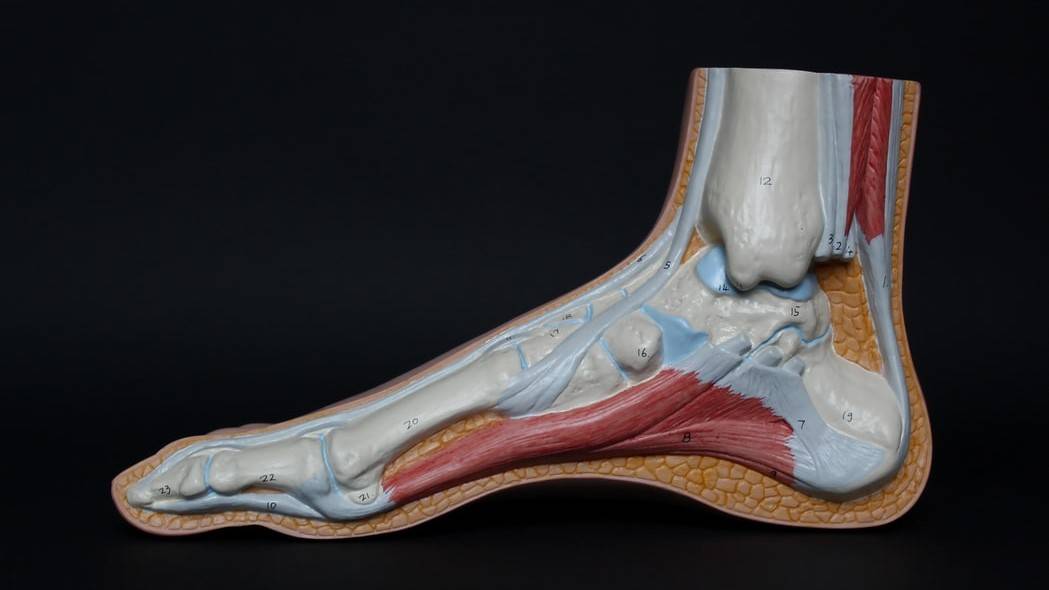Der griechische Halbgott Achilleus muss ein Läufer gewesen sein – denn sein wundester Punkt war die nach ihm benannte Achillessehne. Diese Schwäche hatte andere Gründe als das Laufen – lässt man aber die Mythologie beiseite, könnte Achilleus der Prototyp des modernen Triathleten sein: Körperlich stark, gut trainiert – aber die Achillessehne macht ihn verwundbar.
Die Achillessehne: Immer voll beschäftigt
Die Achillessehne ist die dickste Sehne des Körpers und muss die größten Kräfte über- und ertragen. Sie entsteht, wenn Schollenmuskel und Wadenzwillingsmuskel zusammenkommen und setzt am Fersenbein an. Sie überträgt die Kraft der Wadenmuskeln auf den Knochen. Jeden Tag tut sie das, immer und immer wieder – wenn wir aufstehen, gehen und trainieren.
Irgendwann kann es aber auch der Super-Sehne zu viel werden: Setzen wir der Achillessehne zu viel Action aus, kann ihre Stärke zur Schwäche werden. Durch ihre Dicke wird sie auch schlechter durchblutet als manch anderes Gewebe und kann sich dadurch schlechter regenerieren.
Zu viel Action heißt vor allem: Springen, schnelle Richtungswechsel, dauerhafte hohe Belastung, wenig Pause. Läufer, Spielsportler und Leichtathleten sind daher am häufigsten von Schmerzen oder gar Rissen in diesem Bereich betroffen.
Schmerzen: Wenn die Achillessehne zur Achillesferse wird
Die Achillessehne lässt sich ihre Überlastung zunächst nur wenig anmerken. Kleinste Verletzungen in der nur wenig elastischen Sehne verheilen nur langsam – und die Achillessehne muss immer weiter arbeiten, trainieren und funktionieren. Die Mikrotraumata bekommen keine Zeit zum Verheilen. Irgendwann entzünden sie sich– dann kommt auch der Schmerz. Lässt man der Sehne immer noch keine Zeit für die Regeneration, entstehen Narben, die die Sehne noch unelastischer machen.
Charakteristisch ist vor allem der sogenannte „Anlaufschmerz“: Direkt nach dem Aufstehen sind die Schmerzen am Größten. Die Beweglichkeit des Sprunggelenks ist eingeschränkt, die Wadenmuskulatur verhärtet sich. Ist die Sehne stark entzündet, tritt sogar eine Rötung auf und Entzündungen und Narben bilden fühlbare Verwachsungen. Häufig sind die Schmerzen vor allem weiter unten am Fersenbein am stärksten.
Wenn wir der Achillessehne dann immer noch nicht genügend Ruhe gönnen, können die Beschwerden chronisch werden. Im extremsten Fall kann die Sehne sogar reißen – das passiert meist plötzlich mit einem peitschenartigen Knall.
Verkürzt, verspannt, überlastet: Die Ursachen für Schmerzen
Die Ursachen für die Überlastung der Achillessehne und die anschließenden Schmerzen sind vielfältig – aber sie sind auch altbekannt. Wie bei so vielen triathlonspezifischen Verletzungen stehen die folgenden Faktoren im Fokus: Übertraining, Schuhwerk und muskuläre Dysbalancen.
Unsere Bewegungen kommen immer durch das komplexe Zusammenspiel zwischen Muskeln, Sehnen und Knochen zustande. Ist in diesem Zusammenspiel eine Komponente zu schwach oder arbeitet sie nicht so, wie sie soll, wird das System auf Dauer eben überlastet:
- Eine verkürzte oder zu schwache Wadenmuskulatur belastet die Achillessehne bei jedem Laufschritt enorm.
- Fehlstellungen wie Hohlfüße, Senk- und Spreizfüße oder O- und X-Beine bedeuten ebenso Stress für die Sehne wie zu alte, ausgelaufene Schuhe.
- Zu wenig Trainingspause bzw. zu schnelle Belastungssteigerung führen zu übermüdeter Muskulatur und zu wenig Regenerationszeit.
- Gewöhnungsbedürftig für die Sehne ist auch vermehrtes Tempotraining auf der Bahn oder Laufen im Gelände.
- Auf- und Abwärmen sowie Stretching und Athletiktraining werden oft vernachlässigt – Sehnen und Muskulatur sind auf die Belastung nicht vorbereitet und werden bei der Regeneration zu wenig unterstützt.
- Eine plötzliche Umstellung der Technik, z.B. auf das Vorfußlaufen, überfordert Muskulatur und Sehne.
Natürlich sind die Ursachen für Beschwerden komplex und sehr individuell. Die Schmerzen sind aber ein Beweis dafür, dass etwas nicht in Ordnung ist. Es gilt herauszufinden, was wir verbessern sollten.
Behandlung von Achillessehnenbeschwerden
Genug Zeit für die Ursachenforschung gibt es in der Trainingspause, die aufgrund der Beschwerden nötig ist. Die meisten Triathleten und Läufer nehmen die Schmerzen zunächst nicht ernst genug und trainieren weiter – und verschlimmern somit die Schmerzen.
Die Pause kommt meist zu spät: Wenn die Schmerzen dann länger als zwei Wochen anhalten, sollte ein Arzt aufgesucht werden. Gerechnet wird mit mindestens sechs Wochen Pause, um der schlecht durchbluteten Sehne genug Zeit zur Erholung zu geben.
Der Arzt entscheidet auch, ob Salben oder entzündungshemmende Mittel zum Einsatz kommen. Nachhelfen könnt ihr mit Kühlung der schmerzenden Stellen – 15-20 Minuten mit dem Eisbeutel reichen, um die Schmerzen zu stillen und um die Durchblutung anzuregen.
Das Lauftraining solltet ihr erst wieder beginnen, wenn ihr komplett schmerzfrei laufen und springen könnt.
Vorbeugung
Egal, ob ihr noch keine Achillessehnenbeschwerden hattet oder gerade aus einer Trainingspause deswegen zurückkehrt: Die oben stehenden Ursachen könnt ihr relativ einfach beheben bzw. abschwächen und somit Achillessehnenbeschwerden vorbeugen.
- Investiert in gutes und vor allem passendes Schuhwerk. Evtl. sind Einlagen nötig, um Fehlstellungen auszubessern.
- Steigert die Trainingsbelastung nur langsam.
- Gewöhnt eure Strukturen gezielt an Tempotraining, und Geländeläufe, genauso wie an Technikumstellungen.
- Dehnen und Kräftigen der Waden- und Fußmuskulatur sollte fester Bestandteil des Trainings sein.
- Auf- und Abwärmen nicht vergessen!




















